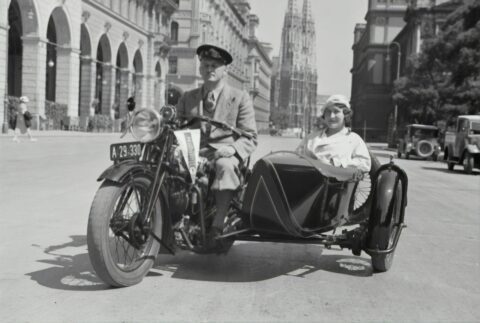Introduction to the Evolution of Transportation
Buckle up, history buffs and tech enthusiasts! We’re about to embark on a thrilling journey through time, exploring the remarkable evolution of transportation. From humble horse-drawn carriages to cutting-edge autonomous vehicles, the way we move from point A to point B has undergone a jaw-dropping transformation over the years. As we delve into this riveting tale of innovation and progress, prepare to be amazed by how far we’ve come – and get ready for a glimpse into what the future holds. So sit tight (or should I say “strapped in”?), because this is going to be one wild ride!
Early Forms of Transportation: Horse-Drawn Carriages and Steam Engines
During the early days of transportation, before the advent of automobiles and airplanes, people relied on simpler means to get from point A to point B. One such mode of transport was the horse-drawn carriage. These charming vehicles were a common sight in cities and towns, whisking passengers away with the rhythmic clip-clop of hooves on cobblestone streets.
Horse-drawn carriages offered a level of elegance and sophistication that is often romanticized today. They provided a sense of luxury and comfort as passengers sat back on plush seats while being transported through bustling city streets or picturesque countryside. However, they were not without their limitations. Travel distances were limited by the endurance of horses, and speed was dependent on their pace.
Another significant development during this time was steam engines. These revolutionary machines powered locomotives that transformed long-distance travel forever. Steam engines allowed for faster speeds over greater distances than ever before, making it possible to connect far-off places efficiently.
The introduction of steam-powered trains revolutionized trade and commerce by connecting previously isolated regions across vast distances quickly. The expansion of railways brought about an unprecedented era of economic growth and societal change.
Both horse-drawn carriages and steam engines laid the foundation for modern transportation systems we enjoy today – they set in motion a series of technological advancements that would shape our world forever.
The Invention of the Automobile and Its Impact on Society
The invention of the automobile revolutionized transportation and had a profound impact on society. Before automobiles came into existence, people relied on horse-drawn carriages and steam engines to get around. These modes of transportation were slow and limited in range, making long-distance travel a time-consuming endeavor.
With the invention of the automobile, however, everything changed. Suddenly, individuals could travel faster and farther than ever before. The ability to drive from one city to another in a matter of hours was an incredible leap forward in terms of convenience and accessibility.
Not only did automobiles make personal travel more efficient, but they also played a crucial role in shaping cities and infrastructure. Roads were built to accommodate these new vehicles, connecting towns and cities across vast distances.
Furthermore, the automobile industry created numerous job opportunities for both skilled workers and assembly line laborers. As production increased, so did employment rates – contributing significantly to economic growth.
However, with progress comes challenges as well. The rise of automobiles led to increased traffic congestion in urban areas. Additionally, concerns about pollution and its impact on air quality emerged as cars became more prevalent.
Despite these challenges though; there is no denying that the invention of the automobile transformed societies worldwide by providing unprecedented mobility while simultaneously creating new societal issues that needed addressing.
Modern Innovations in Transportation: Electric and Autonomous Vehicles
Modern Innovations in Transportation: Electric and Autonomous Vehicles
With the advancement of technology, transportation has also undergone a remarkable transformation. One of the most significant developments in recent times is the rise of electric and autonomous vehicles.
Electric vehicles (EVs) have gained popularity due to their eco-friendliness and energy efficiency. These cars are powered by rechargeable batteries, eliminating the need for gasoline or diesel fuel. Not only do they reduce carbon emissions, but they also help decrease air pollution in urban areas.
The emergence of autonomous vehicles (AVs) has revolutionized transportation even further. AVs are equipped with advanced sensors, cameras, and artificial intelligence systems that allow them to navigate without human intervention. This technology holds immense potential for improving road safety and reducing accidents caused by human error.
Moreover, AVs can enhance traffic flow efficiency as they communicate with each other through interconnected networks. This could lead to reduced congestion on roads and more efficient use of infrastructure.
However, it is important to consider the pros and cons of these innovations. While EVs offer environmental benefits, there are still challenges concerning battery range limitations and charging infrastructure availability.
Similarly, although AVs promise increased safety on roads, concerns over cybersecurity vulnerabilities remain. Additionally, ethical considerations regarding decision-making algorithms in critical situations need careful consideration.
In conclusion,
Modern innovations such as electric vehicles and autonomous vehicles have transformed our perception of transportation. With their environmental benefits and potential improvements in road safety and traffic flow efficiency – we’re witnessing an era where sustainable mobility is becoming a reality! As society continues to embrace these advancements while addressing challenges along the way – we can look forward to a future where transportation becomes not just convenient but also safer for all!
Pros and Cons of Autonomous Vehicles
Pros and Cons of Autonomous Vehicles
Autonomous vehicles, also known as self-driving cars, have been a topic of great interest and debate in recent years. While they hold the promise of revolutionizing transportation, it is important to consider both their advantages and disadvantages.
One major advantage of autonomous vehicles is improved road safety. With advanced sensors and algorithms, these vehicles can react faster than humans, potentially reducing accidents caused by human error. Furthermore, autonomous vehicles are programmed to follow traffic laws consistently, eliminating reckless driving behavior.
Another benefit is increased convenience and productivity. Imagine being able to read a book or catch up on work during your daily commute! With autonomous vehicles doing the driving for us, we could reclaim valuable time that was previously wasted behind the wheel.
Additionally, autonomous vehicles have the potential to reduce traffic congestion. By communicating with each other through interconnected systems, they can optimize routes in real-time to avoid congested areas. This would lead to smoother traffic flow and shorter commuting times for everyone.
However, there are some concerns associated with autonomous vehicles as well. One major concern is the loss of jobs for professional drivers such as taxi drivers or truckers. As more industries adopt autonomous technology, there may be a significant impact on employment rates within certain sectors.
Privacy is another issue that arises with autonomous vehicles. These cars collect vast amounts of data about their passengers’ habits and preferences which raises questions about how this information will be used and protected.
Moreover , there are ethical dilemmas surrounding decision-making algorithms in situations where accidents cannot be avoided entirely but require choosing between different outcomes (e.g., protecting occupants versus pedestrians). Resolving these issues requires careful consideration from policymakers and technologists alike.
In conclusion,
While there are clear advantages to adopting autonomous vehicle technology such as improved road safety , increased convenience ,and reduced congestion ,
we must also address concerns related to job displacement , privacy infringement ,and ethical challenges.
By carefully considering these pros and cons, we can work towards maximizing the benefits of autonomous vehicles while mitigating their
Future Predictions for Transportation Evolution
Future Predictions for Transportation Evolution
As we look ahead to the future, it is clear that transportation will continue to evolve at an unprecedented pace. The advancements in technology and the growing demand for more efficient and sustainable modes of transport are driving this evolution.
One of the most exciting predictions for transportation is the widespread adoption of autonomous vehicles. With ongoing research and development, these self-driving cars have the potential to revolutionize our roads. They can enhance safety by reducing human error and improving traffic flow. Additionally, they hold promise in terms of accessibility, as they could provide mobility options for those who are unable to drive due to age or disability.
Another area where we can expect significant progress is electric vehicles (EVs). As concerns about climate change and air pollution increase, there is a growing push towards transitioning from internal combustion engines to EVs powered by clean energy sources like electricity. This shift will not only reduce carbon emissions but also decrease our dependence on fossil fuels.
Furthermore, advancements in alternative modes of transportation such as hyperloop systems and flying taxis could reshape how we travel long distances or navigate congested urban areas. These innovative technologies aim to make travel faster, more efficient, and environmentally friendly.
However, with every new development comes challenges that need careful consideration. As autonomous vehicles become more prevalent on our roads, issues related to cybersecurity and ethical decision-making algorithms must be addressed. Moreover, infrastructure upgrades will be necessary to support electric vehicle charging stations across cities.
Despite these challenges, one thing remains certain: transportation will continue its evolutionary journey driven by innovation and societal needs. While we cannot predict all the developments that lie ahead with certainty—a decade ago few would have predicted ride-sharing services like Uber—what seems certain is that future generations may marvel at how far transportation has come since horse-drawn carriages!
So buckle up; fasten your seatbelts because the future holds endless possibilities when it comes to transforming how we move from point A to point B. Whether it’s autonomous vehicles zipping seamlessly through city streets







